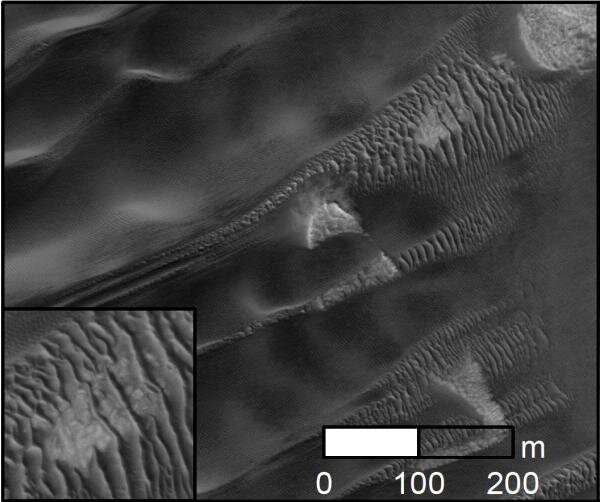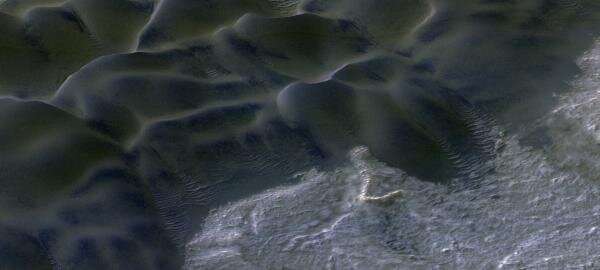Megaripples, intermediate-scale bedforms caused by the action of the wind, have been studied extensively and thought to be largely inactive relics of past climates, save for a few exceptions. A new paper by Planetary Science Institute Research Scientist Matthew Chojnacki shows that abundant megaripple populations were identified across the north polar region of Mars and were found to be migrating with dunes and ripples.
Megaripples on Mars are about 1 to 2 meters tall and have 5 to 40 meter spacing, where their size falls between ripples that are about 40 centimeters tall with 1 to 5 meter spacing and dunes that can reach hundreds of meters in height with spacing of 100 to 300 meters. Whereas the megaripples’ migration rates are slow in comparison (average of 0.13 meters per Earth year), some of the nearby ripples were found to migrate an average equivalent of 9.6 meters per year over just 22 days in northern summer—unprecedented rates for Mars. These high rates of sand movement help explain the megaripple activity.
“Using repeat HiRISE images acquired over long durations—six Mars years or 13 Earth years—we examined the dynamic activity of polar bedforms. We found the thin Martian atmosphere can mobilize some coarse-grained megaripples, overturning prior notions that these were static relic landforms from a past climate. We mapped megaripples and adjacent bedforms across the north polar sand seas, the most expansive collection of dune fields on Mars,” said Chojnacki, lead author of “Widespread Megaripple Activity Across the North Polar Ergs of Mars” that appears in Journal of Geophysical Research: Planets.

Polar bedform sites with active megaripples, as viewed in HiRISE. Approximate transport direction is toward the lower left and the inset is 100 meters wide. © HiRISE data: NASA/JPL/University of Arizona
Part of the uncertainty when studying planetary polar landforms is the long, cold polar winter that eventually covers the region in carbon dioxide and water ice. For wind-driven bedforms, such as megaripples, that means they are unable to migrate for nearly half of the year. “However, it appears the late spring and summer winds that descend off the polar cap more than make up for these other periods of inactivity,” Chojnacki said.
“Megaripples were found to be widespread across the region and migrating at relatively high rates relative to other sites on Mars that are at lower latitudes. This enhanced activity is likely related to the greater sand fluxes found for neighboring dunes which are driven by summer-time seasonal winds when polar ice is sublimating. This supports the idea that much of the Martian surface is actively being modified and not just ancient or static.” Chojnacki said. “In contrast, other megaripples appear to be stabilized, a likely result of inter-granular ice within low wind areas.”
More information:
Matthew Chojnacki et al, Widespread Megaripple Activity Across the North Polar Ergs of Mars, Journal of Geophysical Research: Planets (2021). DOI: 10.1029/2021JE006970
Provided by
Planetary Science Institute
Citation:
Widespread megaripple activity found on Martian north pole area (2022, January 12)
